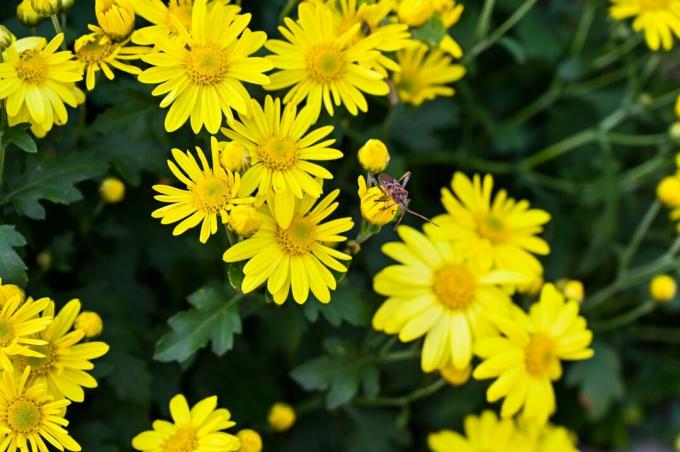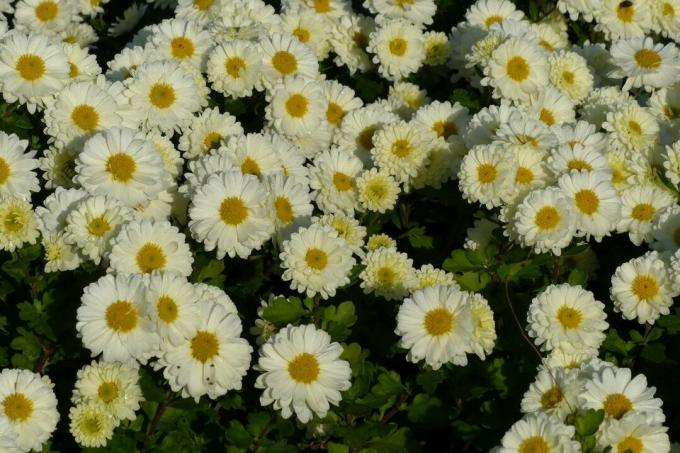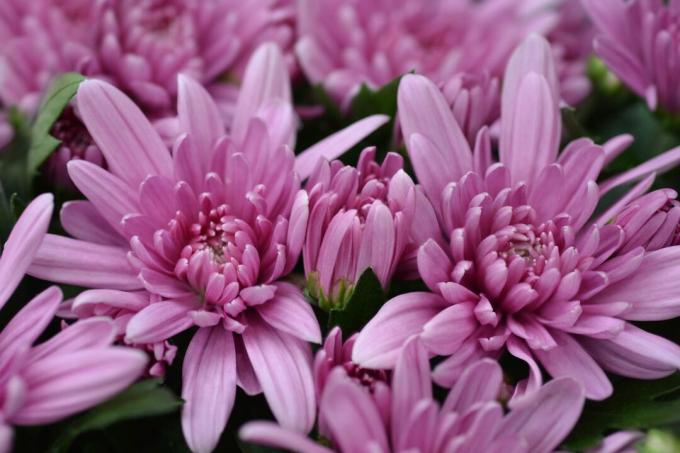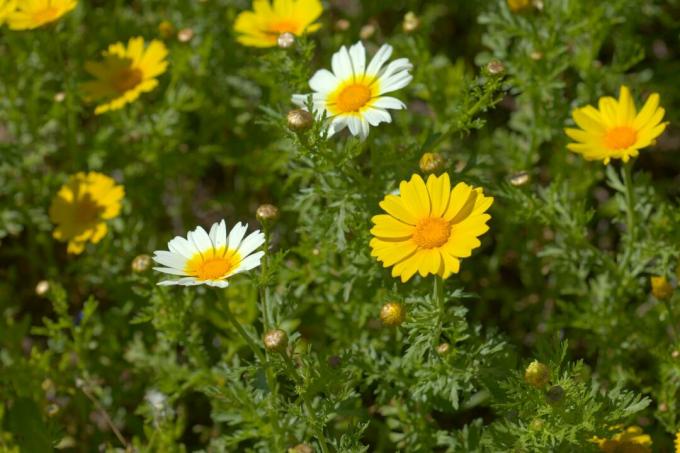Autumn chrysanthemums are the ideal addition to the garden because they guarantee one Flowers late in the year: The autumn chrysanthemums can flow into November involve.

Fall flowers like the fall chrysanthemum (Chrysanthemum indicum-Hybrids) not only bring color to the garden, but also insects. They are grateful for the food source late in the year. Learn more about the properties and requirements of the autumn chrysanthemum below. We also present the most beautiful varieties.
contents
- Autumn chrysanthemums: origin and characteristics
- The most beautiful varieties of Chrysanthemum indicum
- Plant autumn chrysanthemums
- Proper care
- Is Chrysanthemum indicum hardy?
- Are Fall Chrysanthemums Poisonous?
Autumn chrysanthemums: origin and characteristics
Often autumn chrysanthemums are also referred to as winter asters. They belong to the same family, namely the Asteraceae. The perennial, herbaceous plant has its origin in East Asia. The main commercially available hybrids of the
Chrysanthemum indicum are pure cultivated forms that descend from the species found in East Asia to Japan.The growth of the autumn chrysanthemum is characterized by a spherical shape. Depending on the variety, it can reach a height of 50 to 120 centimeters. The dark green, deeply incised leaves, which have an aromatic scent, sit on the thinly hairy above-ground parts of the bushy perennial. They are often barely visible when the plant is in bloom, as they are covered all around by the cup-like flowers. These are formed from ray florets and tubular florets, with the double varieties containing more rows of ray florets.

The perennials with double flowers have more of a purpose as an ornamental plant and beautiful cut flower. If you also want insects to enjoy the plants, you should choose varieties with unfilled flowers. The color spectrum of the ray florets is wide. Most varieties have some frost tolerance, but are not reliably winter hardy.
How long do fall chrysanthemums bloom? Due to the different beginning of the flowering period, autumn chrysanthemums can be divided into early, mid-early and late-blooming varieties. The early-blooming varieties can start to bloom as early as June, the mid-early ones from August or September and the latest varieties begin to bloom in October. Most varieties end the flowering period in November.
The most beautiful varieties of Chrysanthemum indicum
Below we introduce you to four special varieties of autumn chrysanthemum that are Chrysanthemum indicum- Hybrid acts. All of them have sufficient winter hardiness in our latitudes down to around - 17 ° C.
- "Fog Rose": The specialty of the Nebelroseˈ variety are the enchanting, silver-pink flowers. They are densely filled and slowly unfold their ray florets as they bloom. With a height of around 100 to 120 cm, the variety is also suitable as a cut flower.
- poetry: This bee-friendly variety is adorned with an initially creamy white and then pure white flowers from October to November. The fragrant flowers are semi-double and, due to their persistence, are very suitable for the vase. The plant becomes about 100 cm tall.

- ˈApricotˈ: The double, apricot-colored flowers of the ˈApricotˈ variety are already enchanting from July. The vigorous variety carries the flowers into November. It can also be used as a cut flower and grows to around 70 to 90 cm.
- ˈBee: This variety is a very special splash of color for every garden. Its golden yellow pompom flowers with an orange-brown center can be seen from the end of September.

Plant autumn chrysanthemums
The autumn chrysanthemum prefers a sunny and sheltered location with a well-drained, nutrient-rich and lime-rich substrate. The autumn chrysanthemum is at risk of freezing to death in locations with soils that are too rich in nutrients, too moist and prone to waterlogging. Suitable times for planting the perennial are either in spring or in autumn after the flowering period has ended. The chrysanthemums are not set any deeper than they were previously in the pot. The perennials are best planted individually, then they can best unfold and look the most beautiful.
Chrysanthemum indicum can also be grown in pots. For this, the purchased plant should be transplanted into a much larger pot, which ideally has a drainage facility for excess irrigation water. A high-quality potting soil that meets the nutritional requirements of your autumn chrysanthemums is suitable as a substrate. An example of such a quality soil is our peat-free soil Plantura organic potting soil. With the contained fertilizer, the soil offers optimal starting conditions for your perennials and also ensures a lush and long-lasting bloom.
Tip: When planting, it is advisable to use some lime if necessary to prepare the soil for the chrysanthemums. For example, our Plantura organic lawn & garden lime be used. Liming is particularly recommended in more acidic soils, because chrysanthemums cannot effectively absorb nutrients from the soil in excessively acidic conditions. In addition, lime improves the soil structure and thus also the rooting capacity and water permeability of the soil.
Proper care
To keep your fall chrysanthemums in top shape, there are a few maintenance steps to follow.
Watering autumn chrysanthemums: Permanent moisture should be avoided with the perennials: do the finger test before watering again.
Trim, cut and split: If all withered flowers are regularly cleaned out during the flowering period, the autumn chrysanthemum will be supported in the formation of further buds. It is also recommended that the perennial rootstock be divided about every two to three years in order to maintain more vital plants or to multiply them.

Fertilize autumn chrysanthemums: With fertilization, which plays an important role in potted culture in particular, the plants can be supplied with the necessary nutrients from March to September. For this purpose, a fertilizer in granulate form can be used in the bed. A liquid fertilizer that is administered via the irrigation water is best suited for the pot. Our resource-saving produced Plantura organic flower & balcony fertilizer for example, through such a pouring application, it is applied every one to two weeks in the specified period. It provides nitrogen and potassium for strong and healthy growth and compensates for its reduction in phosphorus with the help of beneficial microorganisms.
Post-flowering care: When the autumn chrysanthemums have faded, it is a good idea to leave the plant with its withered shoots for the winter, as these serve as natural frost protection. In spring, the perennial can then be cut back close to the ground before new growth.
Is Chrysanthemum indicum hardy?
In trade there are mainly Chrysanthemum indicum-Hybrids to be acquired, which are assigned to the winter hardiness zone Z7. This means that they can withstand temperatures of around - 12 ° C to - 17 ° C. However, among the different varieties there are also plants that are less winter hardy. That is why you should research and choose carefully when buying. If your autumn chrysanthemums were only planted in autumn, they definitely need winter protection. The root disc of the plant can be protected by covering it with the cut, withered shoots, coniferous branches or straw. Alternatively, a breathable garden fleece with which the perennial is covered is also suitable.
Are Fall Chrysanthemums Poisonous?
If you have pets, you should be aware that chrysanthemums are very poisonous to cats, dogs, rodents, but also to grazing animals. All parts of the plant can cause severe symptoms of poisoning.
There are indeed edible chrysanthemums (Glebionis coronaria), which, unlike most types of chrysanthemums, can be easily consumed by humans. at Chrysanthemum indicum However, as a precaution, the ingestion of the plant parts by children or adults should be avoided, even if there is no clear evidence of their toxicity to humans.

In case you have more expert knowledge and care tips to others Chrysanthemums want to collect, it is worth reading our special article. More decorative Autumn flowers for garden and balcony we present you in our overview.



